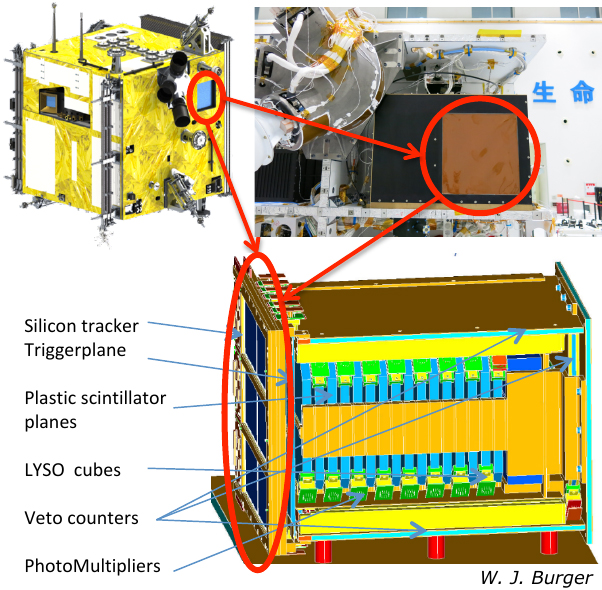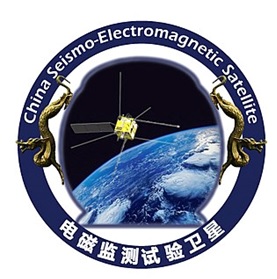

|
CSES - CHINA SEISMO ELECTROMAGNETIC SATELLITE
The CSES (China Seismo-Electromagnetic Satellite) scientific space missions are dedicated: to monitoring electromagnetic field and waves, plasma and particle perturbations of the atmosphere, ionosphere and magnetosphere induced by natural sources and anthropocentric emitters and to study their correlations with the occurrence of seismic events. They will investigate the structure and the dynamic of the topside ionosphere, the coupling mechanisms with the lower and higher plasma layers and the temporal variations of the geomagnetic field, in quiet and disturbed conditions. Data collected during the missions will also allow to study solar-terrestrial interactions and solar physics phenomena, namely Coronal Mass Ejections (CMEs), solar flares and cosmic ray solar modulation. The lithosphere-atmosphere-ionosphere coupling is a complex subject involving many physical effects and interactions that occur from the Earth surface up to the magnetosphere. The investigation of such coupling mechanisms - and in particular of the, partially unknown, behavior of the iono-magnetosphere transition region - is of fundamental importance for Earth remote sensing, monitoring of the near-Earth electromagnetic environment and studying of natural hazards. A great part of these effects is caused by natural non-seismic and anthropogenic electromagnetic emissions, but of particular relevance are the electromagnetic disturbances associated with the seismic activity that can produce ionospheric perturbations as well as the precipitation of particles from the Van Allen belts, observed before, during and after earthquakes of medium and strong magnitude. All of these phenomena must be distinguished from those induced by sources external to the geomagnetic cavity and by atmospheric events. In fact, an important role in controlling the dynamic of the topside ionosphere is played by the Sun – that generates (regular and irregular) variations of the lithosphere-ionosphere-magnetosphere parameters by impulsive events as solar Coronal Mass Ejections and Solar Flares – as well as by tropospheric activity (lightning, TLE, etc.).
Main CSES scientific topics can be found at the following links:
CSES Satellite The satellite is based on the Chinese CAST2000 platform. The payload onboard consists of two High-Energy Particle Detectors (HEPD, HEPP) to measure the particle flux and energy spectrum, a Search-Coil Magnetometer (SCM) and a High Precision Magnetometer (HPM) to measure the components and the total intensity of the magnetic field, respectively, an Electric Field Detector (EFD) to measure the electric field, a Plasma analyzer and a Langmuir probe to measure the disturbance of plasma in ionosphere, a GNSS Occultation Receiver and a Tri-Band Beacon to measure the density of electrons. Scientific Heritage Electromagnetic effects (ULF/ELF waves observed on ground and at Low Earth Orbit altitudes), anomalies in ionospheric and atmospheric parameters (plasma density, TEC, VLF transmission) and bursts of electrons precipitating from the Van Allen Belts can be considered one of the main pre-seismic phenomena. Reports on observations from space of earthquake-related signals in the ELF-VLF frequency band in the ionosphere and low magnetosphere have appeared in the last years. In particular, the DEMETER mission has showed an increasing of the plasma density in vicinity of the epicenter of a future earthquake days before the main shock; the intensity of these anomalies was enhanced when the earthquake magnitude increased and reduced when the depth increased. Relevant are the researches performed by experiments on board satellites concerning flux disturbances of Van-Allen trapped particles. Anomalous increase of low-energy electron and proton counting rate was observed several hours before the occurrence of moderate and large-magnitude earthquakes. The results of a recent analysis, carried out by data obtained with GAMMA-1, Sampex-PET and ARINA missions, are shown in Fig. 1. A spatial and temporal statistical correlation between seismic activity and the charged particle precipitation from the lower limit of the Van Allen radiation belts cleary appears. A model for this process is shown in Fig. 2. During an earthquake preparation, a lightning discharge could radiates ELF and VLF electromagnetic waves into the Earth-ionosphere waveguide which propagate away from the source, illuminating a large region of the bottomside ionosphere; a portion of the radiation incident on the bottomside ionosphere leaks through to the topside ionosphere, experiencing collisional losses along the way, and coupling into the whistler mode of propagation; as the whistler propagates, it alters the pitch angles (the angle between the particle's velocity vector and the local magnetic field) of energetic electrons, causing some electrons to precipitate into the dense upper atmosphere within one bounce period. The particle detectors (HEPD and HEPP) on board CSES satellite are specialized to carefully study these intriguing effects.
High-Energy Particle Detector (HEPD)
HEPD detector onboard of CSES-01 (ZH-1) Satellite (credit: W.J. Burger). The High-Energy Particle Detector (HEPD), developed by the Italian Collaboration under the lead of INFN, detects electrons, protons and light nuclei. The main objective is to measure the increase of the electron and proton fluxes due to short-time perturbations of the radiation belts caused by solar, terrestrial and anthropic phenomena. The energy range explored is 3 - 100 MeV for electrons and 30 - 200 MeV for protons. The instrument consists of several detectors. Two planes of double-side silicon microstrip sensors placed on the top of the instrument provide the direction of the incident particle. Just below, two layers of plastic scintillators, one thin segmented, give the trigger; they are followed by a calorimeter, constituted by other 16 scintillators and a layer of LYSO sensors. A scintillator veto system completes the instrument. The power supply and electronics are inserted in a box placed at one side of the detector. The HEPD is contained in an aluminum-honeycomb box. Four different models have been realized and fully tested: Electrical Model (EM), Structural and Thermal Model (STM), Qualification Model (QM) and Flight Model (FM).
Main activities carried out at SSDC:
The main activities carried on by members of INFN @SSDC are:
CSES Collaboration
|
|

 Time Difference Distribution. Zero is the current time of the particle burst. ΔT is the time difference between earthquake and the detected electron burst. a) GAMMA-1 mission, 1990-1992, Altitude 350 km, Inclination 51°, E > 50 MeV b) SAMPEX/PET mission 1992-1999, Altitude 520-740 km, Inclination 82°, 4≤E≤15 MeV c) ARINA mission 2006-in operation, 3≤E≤30 MeV
Time Difference Distribution. Zero is the current time of the particle burst. ΔT is the time difference between earthquake and the detected electron burst. a) GAMMA-1 mission, 1990-1992, Altitude 350 km, Inclination 51°, E > 50 MeV b) SAMPEX/PET mission 1992-1999, Altitude 520-740 km, Inclination 82°, 4≤E≤15 MeV c) ARINA mission 2006-in operation, 3≤E≤30 MeV

